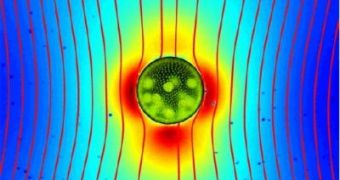Two separate research groups have studied the role that the ocean's tiniest creatures have in mixing nutrients, by measuring the fluid flow that surrounds these freely swimming microorganisms.
These experiments focused on two types of microbes that have shed some light on the way that one creature's movement affects its neighbors, ultimately leading to a collective motion of microorganism hordes.
Researchers at the University of Cambridge tracked the motion of small tracer beads within the fluid surrounding the minute swimmers, in order to observe the flow that they produce.
They used this technique on two very different types of creatures: a form of algae called Chlamydomonas reinhardtii, very small, of blue-green color, which swims by paddling with a pair of whip-looking flagella, and a bigger, spherical algae, called Volvox carterii which pushes itself thanks to the thousands of flagella covering its surface.
Thanks to the tracer beads, the scientists saw that the two organisms have different flow patterns, much more complex than previously thought.
The second study was carried out by the Haverford College in Pennsylvania, where researchers used a high-speed camera to record the flow of tracer particles around Chlamydomonas within a thin, two-dimension film of fluid over the course of a single stroke of its flagella.
These two studies were related and they helped scientists develop new models that predict aquatic microorganisms' associated fluid motions.
This should help clear up the way that microbes can stir bodies of water, and maybe one day shed some light on the role that plankton plays in the carbon cycle, while mixing the oceans waters.
Also, the two experiments explain the way that nutrients, chemicals and oxygen are distributed in lakes and oceans, with the help of microscopic swimmers' large scale dance.
The two experiments are detailed in today's issue of the APS journal Physical Review Letters.

 14 DAY TRIAL //
14 DAY TRIAL //